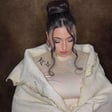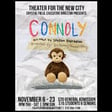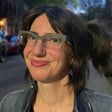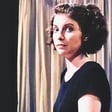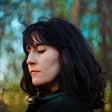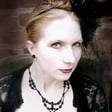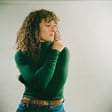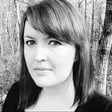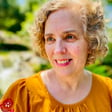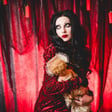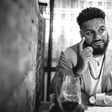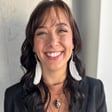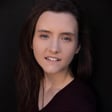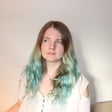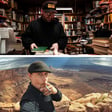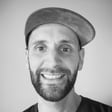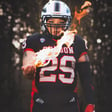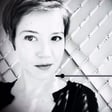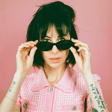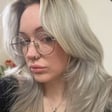Become a Creator today!Start creating today - Share your story with the world!
Start for free
00:00:00
00:00:01

Shannon Kringen
Multi Media Artist Shannon Kringen grew up in San Diego California and Whidbey Island Washington. She is a self taught photographer with a background in Graphic Design. She has worked as a figure model in Seattle since 1992. She completed her BA degree in Arts and Literature from Antioch University in 2013. She sees her creative expression as a tool to connect with community and a way of increasing self awareness and tap into a deeper wisdom within.
We talked about Hundertwasser
Music!
Transcript
Introduction and Guest Welcome
00:00:17
Speaker
Hey, everybody, this is Ken Vellante with the Something Rather Than Nothing podcast. And Shannon Kringen up from Seattle, multivariate artist, also known as the Goddess Kring. Good goodness gracious, that's a heck of a lead in. Shannon, welcome on to the program. I'm so excited to be able to chat with you. Thank you so much. This is a fun. um i like I like being here. Thank you for being for having me come
Cultural Influences and Artistic Journey
00:00:44
Speaker
here. Yeah, I yeah i'm ah um
00:00:49
Speaker
i i yeah yeah I'm a big fan of Seattle. i'm I'm from the East Coast originally, from Rhode Island. I've been out on the West Coast for a few years. and um First time I went to Seattle, I was overwhelmed by the scope and size of it. I didn't realize it was such a big big honking city.
00:01:09
Speaker
and then being able to drop into aspects of the culture and the arts which I've done for the for the last few years. I was super excited to run into your work and all the different things um ah that you that you do there and known in parts up there as Goddess Kring and I saw the ah ah the one of the more beautiful ah art cars that I've ever seen in my life that that you've created. Okay, Shannon, you're you're up there doing this. art tell tell us about Tell us about the art that you do and what you've described to me or mentioned as an improvisational approach. Tell us about your art.
00:01:53
Speaker
ah Everything I do seems to be improvisational and I was raised by um my my dad. I wrote comedy and folk music, but not professionally, but just for fun. and Then my mom exposed me to Eastern philosophy and she does um clay and metal, experimental art. um and So I was sort of raised with some of that.
00:02:23
Speaker
kind of, I think I thought that was normal to have such an eclectic um mix of like, my parents are very artistic minded. And um so I was raised with that. And then I just always did art from the time I was, you know, like little kids draw with crayons. And I just kept, I just kept drawing with crayons. Well, and then I expanded to um painting Well, painting, I write poetry, I paint, I take photos, I record spoken word, and now I'm working on music here in Seattle um with an independent record label, and I do my art car, and for a living I model for for the last 32 years I've been modeling for art
Exploring Art Modeling
00:03:08
Speaker
artists. um
00:03:10
Speaker
Yeah, so that's, I feel like my art modeling is sort of an extension of my own art. yeah Yeah, yeah, let me ask you about the art modeling. I mean a lot of listeners You know that know that there's you know art models, you know behind some pieces of art and painting and otherwise Um, but a lot of folks might know not know like what that's like Like what what is it? What is it like to to to do that and and to have done that for a while? What's the experience like for you? I don't know because i'm kind of a I guess I'm so used to it that it just seems normal. And when I was a little kid, I always had fantasies of being an actor, but I'm a little shot. Like I've always been a little introverted and yet I want to, like I like microphones and cameras and I would play like games in my backyard as a little kid. I grew up in San Diego, California and I
00:04:02
Speaker
remember just being at the beach a lot and I remember having like a fake microphone in my hand. and So when I got into modeling, it was, I found out that you don't have to talk. I mean, you don't have to talk when you're a model. And I thought, oh, because for so for some reason I'm shy about talking in front of people, like being an actor on stage, even though I've done some of it. But I've always wanted to kind of do that. And when I found out about, I took a figure drawing class because I studied um art and graphic design. When I first graduated from high school, I went and studied graphic design and I took figure drawing. And I was fascinated by the men and women that were the figure models drawing
00:04:40
Speaker
And i i don't like I like to do really abstract art with shape and design. And whenever I would draw the model, I didn't really enjoy measuring the model. I like to just do my own shapes. sure yeah um But I fantasize that maybe I could be a model someday. and i thought But I thought, well, maybe I'm too shy.
00:04:58
Speaker
And then I just tried it one time. I met a woman who did it and she's like, you should just try it and see if you like it. And so I just tried it one time. I got myself scheduled. um Like I had a friend take pictures of me and then I submitted that to an art school and then they booked me and they went, oh, you don't have any experience, but you seem like you might be good. And so they tried me out. And then I was like, wow, I felt totally normal. Like when I was up there posing,
00:05:27
Speaker
Aside from I had to learn which poses can I hold, I had to very quickly figure out if they said pose for one minute, like do an action pose. Then I have to figure out what can I hold for one minute versus five minutes versus a whole three-hour pose. You have to really do different kind of poses.
00:05:45
Speaker
Wow. um Yeah, thankss thanks for talking about that. I hope that makes sense what I just said. and It makes sense in particular. I mean, I was thinking when you're talking about it a little bit with some of the softer poses of yoga and when you said three hours, three hours in a position.
00:06:05
Speaker
um ah yeah ah so i wanted to I wanted to ask you, um shan ah you mentioned your mom ah in and in Eastern
Philosophical Influences on Art
00:06:15
Speaker
philosophy. in it's been um you know i've I'm a studied philosophy and one of the big breakthroughs for me in thinking was ah studying Eastern philosophy and maybe Living it or having a perspective towards that has there been an an influence? upon your art from that that experience of Eastern philosophy or that background that came from your mom has that does that is that part of what you do does that show up I Yeah, I think totally um the the biggest
00:06:47
Speaker
Of course, when I was a little kid, I found it slightly annoying that my mom would constantly mention that there's a guy named Krishnamurti who lived in India and wrote books. But his thing was he was not dogmatic at all. He was like, don't follow me. And then everyone wanted to follow him because he said, don't follow me. Go within and question for yourself. And and then everyone wanted to follow him because he said that. and But the non-duality,
00:07:14
Speaker
Well, there are two things about Eastern philosophy that I like. or I have my own intuitive way of doing this. like My mom very loosely kind of studies this. She doesn't like follow any strict philosophy. She just reads all kinds of different Eastern things. But her favorite thing is Advaita Vedanta non-duality. And it's kind of like beyond the duality.
00:07:36
Speaker
and I feel like I like that part beyond the duality. like there's more People think everything is just about the opposites, but not realizing there's something beyond just those two things. and Then that being in the present moment and my improvis the fact that I improvise in my art, whether I'm painting or doing poetry or art modeling, and I've done a little bit of acting and performance art,
00:08:02
Speaker
It all seems like I'm tapping into some kind of present moment awareness. and i'm oh And the themes that, like a lot of my poetry that I write is kind of like about the beyond the duality. But when you talk, almost like you contradict it if you talk about Non-duality cuz then you can't it's hard to talk about it cuz it kind of contradicts itself if you say too much about it. It's kind of hard to explain. Oh, i I'm really I really vibe in with with with what you're saying even though the term non-duality and
00:08:33
Speaker
When I first started studying, oh I i learned first learned um Buddhism, some Eastern philosophy, through the lens of of of philosophy. So, non-duality was kind of like a head-cracking concept of being like, you know, eliminating ah ideas of subject and object and dualities. um Not only teasing that, but radically saying,
00:08:56
Speaker
you know there's one thing there and we build up these categories but when you talk about it just like almost like on this show like talking about something and nothing and subjects and objects it's like every time i talk about it or when you talk about it it's like i don't feel super confident that i'm conveying you know uh the essence of it but um now that makes a lot of sense to me and i actually studied a book non-duality by David Loy, one of my first books that I had read. Are you familiar with that one? No, but I like the title, but I haven't, and I don't think I've seen that specifically. What I liked about it, and and David Loy had done some some writing and work, I believe it was up at university, up in
00:09:40
Speaker
Hawaii. but um it was it was it had ah it was popular You could read it, it had like a popular feel, it was a comfortable read, but it was kind of like a ah way to break down our way of of viewing things non-duality.
00:09:54
Speaker
ah implementate implications for maybe art, ethics, things like
Art as Expression and Connection
00:10:00
Speaker
that. so i really I was really digging when when you were talking about that. I wanted to ask you one of the big conceptual questions since you do this you do this art thing and you do it a lot. is What is art, Shannon? like what what is our What is art itself?
00:10:21
Speaker
I think it can be different things, but I think the first thing that comes to mind is somebody trying to create something beautiful um and a personal self-expression and creating beauty.
00:10:41
Speaker
Some people I think think art, the super realistic people, they think art is a very traditional, like you have to learn to paint or draw realistically and make it look like a photograph and then that's art, like at a technical, maybe that is technical art or like an opera singer that can sing perfect opera and hit every note perfectly. Maybe that's kind of a craft, I guess that's craft, but I think art is way more, I think art is a, well,
00:11:11
Speaker
I think it's for me personally, it's very healing. It's like a personal expression of kind of a personal growth and healing and a way to connect.
00:11:23
Speaker
ah Apparently I've been, I don't believe in labels really, but I might be a little bit on the autism spectrum and I feel like, so for me, my brain is a bit and chaotic and I feel like I kind of live in my own world, but I really want to connect with other people. And I feel like my creative expression helps me Get really into my individuality because I feel kind of like I'm a weird eccentric person that doesn't really belong anywhere. And but when I do my art then I and it's kind of sometimes that feels sad to me that I'm like oh I'm such a weirdo. But then I do my art and share it and then people say they like it and then it makes me feel like oh I belong and when I model it's like that I'm.
00:12:04
Speaker
not real comfortable with groups sometimes, but when I model, I feel happy that I'm part of the group. I'm the model and they're drawing me and I'm part of the group. And so, so I guess for me, art is personal expression and trying to feel connected to community. I really, uh,
00:12:22
Speaker
I really in in and enjoy you saying that. Can you tell me a bit? like It sounds like ah you challenge yourself within that too, right? I mean, because like, as an artist, I mean, and talking about, um you know, how the different ways to communicate and, um you know, do do you find yourself in your art, um challenge yourself to do something? I mean, you're talking about the modeling and you're talking about different things where you're like,
00:12:52
Speaker
is what's that How do you do that for yourself? Because I think about myself as as as an artist in different things that I do. And every once in a while, I'm around these situations. People look at me and they figure I would do anything. Oh, he's going to go in and and say it. But it's such a challenge internally for me. And I get there a lot of the times.
00:13:10
Speaker
um is that Is that part of your experience like kind of pushing yourself into that discomfort and being like, okay, here's the live art I'm doing now. is is How do you do that? Oh, I'm not sure. I guess I've always had a strong intuitive sense of what I want to create. Like like i took what you just said made me think of, I took dance classes as a kid and a part of me wanted to be a great dancer. And I took and i was horrible. I wasn't good at dance. I mean, I'm graceful. I can move. Like when I model, I feel like I'm trying to be graceful and create beautiful shapes with my torso.
00:13:51
Speaker
but i'm not But if I took a dance class, I was not good at following dance steps in unison with other people. like i would We would look in the mirror, and I would always do it backward. like I'm a little dyslexic, so I'd be doing it ballet. I'd be doing it backwards and spinning the wrong way. and Then whenever the teacher said, okay, now we're going to take a break from learning all the dance steps perfectly, and now you can make up your own dance. and Then I was so happy. and The other students,
00:14:19
Speaker
Some of the students preferred to learn normal dance steps and do like a normal dance, whereas I was so happy when she said, now just make up your own dance. And I was like, yeah, I can do that. like i had Ever since I was a little kid, I felt natural. like I could just dance around and make up a dance and then I would love it if that if the other people in the class would dance. Copy me. I'll dance. I'll be the choreographer and and you try to do my steps because that's easier for me than if I try to do normal dance.
00:14:52
Speaker
And I feel like I do that with everything in my life. Like when I art model, I don't look at art like I took art history. So I guess I know famous paintings and poses, but I never look at art books to try to get pose ideas as an art model. I just wing it. I just make it up and I just go with my feel, you know, my gut feeling. And that's I guess that's how I do everything.
00:15:15
Speaker
Yeah, yeah, thank you. yeah um I ah read in ah about you in in reading constant dimension of ah Seattle and known in this Seattle scene. When I talk to artists in different areas, one of the things I like to ask, I'm like, what you know what's it like there for artists and and get that impression? um For you in operating and being in the Seattle art scene, what's what is there about Seattle or in your, what what do you think step What is it about Seattle um that that feels different or is part of how you the place where you make your art?
00:15:56
Speaker
I'm not sure I really know because I'm kind of a daydreamer. So I feel like no matter where, I like i grew up and partly in San Diego and then I went to high school in Whidbey Island and so I was a lot in nature as a teenager. But I feel like no matter like if I had stayed in San Diego, maybe i would just be I would just be doing my art in San Diego, although Seattle is different than San Diego, that's for sure. um I feel like I just kind of live and partly in a dream world. So no matter where I am, I kind of have my daydream way of doing things. But it could be that Seattle is, I do kind of feel like the gloomy weather, like it gets kind of gloomy here in the wind. It's beautiful and green here, but it does rain a lot and gets overcast and it is a little gloomy. and I feel like that kind of moodiness makes people want to
00:16:51
Speaker
Creative people, maybe it's good for writers and musicians partly because of when there's kind of moody weather, I feel like it helps creative people be inspired to like write poems or music or sing or dance or act, like express their mood. So I feel like the the climate here, the kind of cool climate Maybe is fertile ground for creativity, maybe? I think not. Dropping in on yeah drop in on that point. I think there's something there, something about the weirdness or the internal world you can go out or the rain. And it could be very, ah you know, it could be kind of.
00:17:29
Speaker
dower you could be down, your your mood could be down, but it could also be um pacifying as well. So I think but the with the different... ah um i enjoy um I've enjoyed having spent a lot of my life in out east and in the Midwest, and I've been in the Erie Pacific Northwest for about 13 years. It's really a different place for me, and I've experienced that as a different place in something that I'm fascinated with.
00:17:57
Speaker
um and Being in the Portland and being a comic book enthusiast and loving the arts. I was like Not to idealize it in Seattle as well. I was like, I can't believe That there's this much art that there are places like this that there are this many books. So I I just love it. I think I'm in the right in they in the right spot.
Music and Multimedia Exploration
00:18:23
Speaker
um Shannon, we talked a little bit about art itself, but what do you think um the role of art ah is? And I know you've captured this a little bit, but what do you think the role of art is?
00:18:38
Speaker
I think oh overall, I think that's multifaceted, but I feel like it could be, it is a form of um celebrating life and sharing beauty with people, whether it's visual art or performing arts or writing or all the different art forms. um But I think it can be very, for the artist, I mean, because I'm an artist, I guess I see it from internally, not externally as much, but I,
00:19:06
Speaker
For me, it's a ah form of personal... um i Okay, well, one of the things I say about myself is I'm sort of an amplified chameleon, so I kind of feel like sometimes I have no real self, even though I kind of have a strong sense of self, but I feel like it when I do my art, it helps me express the different sides of myself.
00:19:29
Speaker
Like I do a lot of self-portraits and people have said, oh, that's you? Like all of that's you? Like I look totally different in each self-portrait. So I feel like I'm playing around with my individuality. I feel like that's one of my favorite things about art is not just my art, but everyone's art is we we can amplify whatever is unique about ourselves and then create something whether it's a writing or music or visual art, and we amplify whatever's unique about ourselves, and then we share it. We go, look, everyone, this is my unique thing that I do. And then we see how it affects other people.
00:20:09
Speaker
So I guess it can be inspirational, it can be healing, and it can be entertaining. It could also just be soothing and make people feel um happy or positive. Yeah. I love that. um yeah What type of music? You mentioned music.
00:20:26
Speaker
What type of music do you dabble in and create? what well i'm working now with I've been writing poems since I was like 13 years old and i and I played piano as a kid but i I'm not really brilliant at it but I'm kind of a little talented with music. and i um I'm working with this this great guy named Dave Flowers, who's a um he calls himself Super Flower, and he's a um yeah he ah he has an independent record label called Interactive Jack Records, and we're working on um
00:20:59
Speaker
to answer your question. I hope I'm staying on track. that um we're doing We're taking my poetry. It's almost like um like I'm Yoko Ono and he's John Lennon. like You could say, I love Yoko Ono, but you know how people make fun of Yoko for being so avant-garde and so yeah unusual. I love her. Yeah, John Lennon, his music is more beautiful and Yoko's is more abrasive, but if you take the two, put them together.
00:21:24
Speaker
so why um So Dave Flowers has more of a musical. um He knows how to do like ah like but music as beautiful as the Beatles, and yet i don't I love the Beatles, but I don't know how to be like the Beatles. So I'm being more, I'm really inspired by Tom Petty actually, and Dave loves Prince as much as I love Tom Petty. and So we partly came together because we both love ah music and ah and We have synesthesia, we see mut we see shape, both he and I associate music with visual shapes that we see. yeah and So we're creating sort of pop music. I didn't answer your question, but he ah he's a he's a sound engineer and a mixer. like He does all of the technical, amazing mixing, producing of music, but then he also plays the instruments. and so he
00:22:20
Speaker
So it's my voice and my poems. I'm writing most of the lyrics and he's playing synthesizer and he plays drums and guitar. And sometimes we have guest drummers or guest guitar players with us, but it's generally just he and I that create this full, like it sounds like a whole band um because we're creating layers. And so it's kind of pop music. It's kind of eccentric pop music. It's like,
00:22:49
Speaker
We also love people like bjorrk and ah na back in Bjork back in bjorrk and unusual. There's tons of things we're influenced by and we watch music videos together a lot of all different genres of pop, rock, blues, jazz, classical. I love didgeridoo music from Australia, all kinds of interesting. So we kind of are influenced by 20 million different things and then we put it into the, it's sort of pop music, I guess you could say, but it's- yeah yeah i know i love in oh When you mentioned Beck, it's like art music, I'm thinking like Mellow Gold, I think might have been his first, which is like, I think it's an absolutely brilliant work of art, music, otherwise and everything. and um
00:23:43
Speaker
But it's like that ah that the eccentric display of sound and different type of sounds, and of course with Bjork and stuff. So I really vibe with that because it's just so different. there's there' is um So anyways, I'm interested in ah hearing the music too. And like I said, in chatting with you, we could talk about the car, the modeling, the music. ah You ah do a bunch of photography as as well. um Might ask you about that. and Sure.
00:24:13
Speaker
and the yeah but go ahead oh e I didn't mean to interrupt you. Oh no, ah youre it's it's it's it's on it's on you now. ah Photography. Yeah. I was just going to say, sometimes I forget about that I used to have a public, a lot of people in Seattle have heard of me because they know of me from public access television. And I was going to say, because you used to ask about Seattle, Seattle used to have like an amazing public access TV station, because they had a lot of funding for some reason, a lot of that got changed. And now it's not quite like that. But in the
00:24:45
Speaker
But from 1996 to 2011, I did a weekly TV show called Goddess Crane, and I did improvisational monologues. And that was fun for me because I was too shy to get up on stage and do, and but I wanted to. I wanted to perform ah performance art.
00:25:02
Speaker
And I also love Lori Anderson, the performance artist Lori Anderson and ah Miranda July. um I'm influenced by her as well and I met Miranda and some of my videos are in part of her work um she did in the 90s. And so I did public access I feel like my whole life I wanted to do something like perform in some way, but I was too shy. And then when they told me, a friend of mine signed up for a show and I was like, it's free to have your own show. This is amazing. And then i and then they said, um if you don't want to come to the studio, you can just give us a tape. And so I got myself a video camera and I just started videotaping myself and I wasn't sure
00:25:42
Speaker
how I was going to do it, but I figured out how to do, to make a long story short, I learned how to do 28 minute monologue every week for like 15 years. i um oh and It was a relief because i was too shy to because I tried to do it in front of people at this TV studio and i i would get all I would just start laughing and just be silly on camera, but I couldn't do anything too brave and at home alone with my camera. So that's when I got to combine my poetry, music, poetry, because even then I did a little keyboard improvisational keyboard and poetry.
00:26:20
Speaker
So I do a lot of photography, but what I was going to say, I'll talk about my photos. But when I did my public access TV show, I loved it because I was combining, um, and I was known for being nude on camera with body paint, which some people loved. And some people really, I got a lot of negative comments about it, but I felt like I was being an art model. Like I was combining a photography, acting, singing, dancing,
00:26:46
Speaker
Everything, like performing arts are amazing because they're visual. like it's like filmmaking is um like I was making my own little movie every week and I felt like an actor even though I was, I don't know how to explain it, but I was combining everything, my visual ah photography skills with my performing, acting, poetry, and it was also kind of like a video diary. I was kind of doing a video diary.
00:27:15
Speaker
um yeah Yeah. Oh, no, I really i really ah appreciate dropping it. I mean, ah you did it for that long, and it's got a spring, and that's that's the Seattle piece we we found that people might know might know you because of that. on The photos um themselves, I've seen them, they're wonderful photographs on your website.
00:27:37
Speaker
And at the end of the episode, you'll be able to list all the places. But um going through your art, it was just amazing um to to see all the work that you do. um Photography ah itself have a particular meaning or what type of um photos do you tend to do or style? Do you have a way of ah describing that?
Photography and Inspirations
00:28:01
Speaker
ah for Well, I think my i like all like Some people say I should just focus on one kind of photography, but I love... um
00:28:11
Speaker
I guess composition would be the thing because I'm not a really um amazing technical. My expertise is not in the lenses or the technical um technical stuff, but composition seems to be what I focus on more than depth of film photographers. It's all about the depth of field and what's blurry and what's in focus and all this. And for me, it's all about the shapes in the frame. Like I studied graphic design.
00:28:37
Speaker
And I feel like I use the my graphic designs because I've never taken a photography class, but I've taken a lot of painting and drawing and design classes like graphic design. And so whenever I photograph, whether I'm doing a video or still photo, I look in the frame and I i create, it seems like whether I'm, no matter what the subject matter is, I'm always looking at the composition. so i So I try to create beautiful shapes in the frame, especially like triangles. Like in the corners, there's a lot of triangles in my photos. And i I volunteer at the zoo here in Seattle, and I love animals. I love nature. I love plants and animals. So I take a lot of beautiful portraits of plants and animals. But then I also am known for my self-portraits with I do face paint and body paint. And I try to create as many moods as possible. I love black and white and color photography, and I love
00:29:30
Speaker
um ah Water droplets like I love reflections and like transparent layer like if I'm at a bus stop and I see like windows if you see multiple windows you can see reflections in the windows and wow and then you take a photo and it looks even more. Like. um You can see reflections in in windows that you don't realize are there. And then if you take a photo, then you see almost looks like a ghost is there. it's like a So I'm fascinated by reflections and patterns. and like mud When I see mud puddles, I usually see really cool like shapes in water. and So I'm fascinated by nature and reflections and water. and
00:30:13
Speaker
I guess those are, and then urban decay. I also love to photograph like old rusty, cracked paint and like old cars that are rusted out and like texture, textures and stuff. I enjoy that as well. I haven't done some photography, but I ah really became, and Oregon's a good place for it. not Well, it's industrial, but some of the kind of spooky woods kind of objects and things that are there. but um ah love um I grew up in Pawtucket, Rhode Island, manufacturing city you know out out in Rhode Island. you know Older buildings, factories ah emptied you know um that kind of whole space, urban space like dead malls, zombie malls.
00:31:05
Speaker
yeah I'm fascinated by that stuff and that space. But it was something where I'd never look at that. When I was much younger, I'd be like, oh, that's just trash. That's junk. like My brain hadn't gotten to the point where I was like, let me look a little more closer and feel confident in doing that. And I think um becoming comfortable myself as an artist over time, I'd be like, oh, shit. Yeah, I want to look behind that door. And like it's dark back there, but I'll be all right. And I'm going to check it out and see what's going on. so
00:31:36
Speaker
i I like that i like that ah spirit. I got to ask the um the big question of the show, just so we can handle it properly, which is, ah Shannon, why why is there something rather than nothing? oh Yeah, right. This one.
00:32:00
Speaker
Well, I don't know. That makes me think of the thing like if a forest, what do they say, if a tree falls in the forest and nobody's there, does it still make a sound? And I guess I think it still does make a sound.
00:32:13
Speaker
but then that makes me think of the quantum the quantum physics people who say that if you, I forgot what it is, but if we if we expect a certain thing to happen, then it's more likely to happen. Us being a witness affects what actually happens in quantum physics, like literally. like It seems kind of weird, but apparently that's literally true. Why is something on it?
00:32:37
Speaker
I don't know it just makes me think of that and then it makes me think of Zen Buddhism and like less is more and like if you sit in silence. Maybe that's more sometimes that because there's so much conflict in the world right now and everyone's really stressed out and angry and wanting to fix things.
00:32:53
Speaker
And then, and some people say, if you're just a Buddhist monk and you just meditate, you're not really helping the world. But then there's part of me that's thinking that maybe people sitting around being peaceful are doing more for the world than we realize, oh yeah instead of all the people that are out there fighting and trying to win, whatever they're trying to win. So it made just, I don't know how to answer the question you just said, but it made me think of all the, maybe less is more and maybe the more simple we can make things maybe the better i'm not sure but yeah no i think even when you mentioned about
00:33:29
Speaker
You know, the practitioner, you know, um I think you are you you and I might be sensitive in in knowing that theition that the practitioner is engaged ah in healing themselves and in healing the world in some part, whether it's by example. And when you think about conflict, you know, and you think about the idea ah of people's own regulation of themselves, of breath,
00:33:56
Speaker
and meditation and otherwise, there is that deeply rooted radical goal ah to lessen suffering, ah particularly within Buddhism. And gosh, if that ain't a goal or a way to live or a way to demonstrate, then I'm really confused because that, you know, cessation of suffering. So I i think you're right. um Somebody doing, quote unquote, nothing,
00:34:22
Speaker
You know, by sitting down and meditating, I think you could easily say they're the one person doing something at that point, you know, in a certain way of of of looking at it. Thanks for playing on this, something rather than nothing. Oh, sure. And I partly said what I said because I know a lady, I'm friends with this lady.
00:34:40
Speaker
One of my unusual jobs I had was I used to dance at the Lusty Lady way back and in Seattle in the early 90s. Right when I was getting into figure modeling, I started dancing at this place called the Lusty Lady. And then I did my TV show after that. I was going to say that that also trained me for my TV show, but being comfortable dancing around.
00:35:01
Speaker
But um this lady I know, she moved to India. She's one of the people I used to dance with, and she's becoming one of my good friends. I only knew her a little bit when I danced with her, but she moved to India, and she lives on an ashram, and it's fascinating. and so her She's sharing all these amazing photos of India with me, of the monkeys. There's tigers in the forest, apparently, near where she lives, so they have to be careful. and They kind of peacefully coexist with tigers and and monkeys that will grab your groceries right out of your hand. and Peacocks, wild peacocks and mangoes all over the place. And it's fascinating. And I've always, I've never been to India, but I've always been curious. So she's telling me what it's like to live on the ashram in India. And there's only 12 people that live there. It's a very small place. And she's very peaceful. She, her and all the 11 people live, they create a ripple effect and they're all just living in harmony with nature and they're just trying to create um whatever kind of good life they can have there.
00:35:59
Speaker
And they're just making me question everything that I do here in Seattle. I don't know. yeah Because she said it's not easy. Like, it's sort of like rough camping. Where she lives is is kind of rugged. And in terms of the plumbing and electricity, it's a little rugged. It's like rough. It's kind of like camping, she says, but she loves it. She's happy. And she just focuses in a certain way on her her life. She says she's he she's there healing and growing as a person. And I said i find the whole thing fascinating. so Yeah, inspiring. Yeah, inspiring. Yeah. Well, even just the photos, you know, sharing the photos and like like you were saying about like what it is that's expressed and, you know, being able to see those and be like, wow, like that's wildly different. And
00:36:43
Speaker
that's that's not that's really beautiful That's really beautiful to hear. Shannon, where do people find your art websites, social media, Seattle, what you've got going on? Tell people what they need to know.
00:37:01
Speaker
It's kind of all over the place. um I have, like, ah I even have, like, um the camera will say, like, I have a poetry book that I that I published called Kringody and Pazaz. And then I have this other, I i also self published a book, Art Identity and the Sacred.
00:37:18
Speaker
Um, I guess I have it's all over the internet if people just look up. I mean I have my real my regular website my real my real website shannon kringen.com um and um Yeah, and it's got tons of links on it. But if you just search um Goddess Kring or Shannon Kringen. I'm all over i'm ever on ah i' like on TikTok and Instagram and Flickr. I have over 9,000 photos or something. on
00:37:49
Speaker
Flickr, I think. And I have them for free to publish under Creative Commons. And I have over 900 videos on my YouTube channel. I'm kind of like OCD. Like some people say I'm annoying, but I can't even help it. Like I just post constantly on tons of different websites. I don't know how not to. And I can see why some people find it annoying, but um that's my style.
00:38:13
Speaker
And also, um our music is called Kring Flowers, because dave ah Dave Flowers is the musician I'm collaborating with, and then I'm at Kring. So we call it Kring Flowers, and it's on the Interactive Jack Records website. um But we also have it distributed now on like Apple and Amazon and Pandora. and um I forgot Spotify, whatever all the names are of all the main music platforms. We have our music streaming there now called Kring Flowers. And it's like, I think we have 12. We have one record with 12 songs and then two other songs. And um a lot of my music poetry lyrics go with um beyond the duality. Like I have one new song called Polarized Landscape, which is me just trying to express the frustration of living in a time where people are
00:39:05
Speaker
so mean to each other and polarized about different topics, not just politics, but also just food. People argue about what kind of food you should eat or what kind of clothes you should wear or people argue about everything these days. So I've polarized landscape. Yeah.
00:39:22
Speaker
And I wrote a song called Dumpster Diving Boots, which is a true story about hand-painted boots that I painted. And I i got mad. um I don't know why I was so mad. And I threw them in the dumpster. And then I found i saw them for sale a couple of days later in a secondhand store. But they were only $9. And I spent like 20 hours painting these boots. And so I was like, well, that's not fair. $9. But they I threw them in the dumpster. So I was happy that they were for sale.
00:39:48
Speaker
um And then I painted shoes for Tori Amos. And I mentioned, and she wore them on, excuse me, she wore them on stage. um And I mentioned that in the song. And I mentioned Tom Petty. Yeah, Tori Amos. I met her in 1996. I painted shoes for her. They told me her shoe size. us about eight i seven everybody a four i adored tory and a lot of frames tell Tell us a little bit about your your time and painting those shoes.
00:40:15
Speaker
well i Um, it was kind of so a lot of, a lot of synchronicity happened. I was working at ah Kinko's, the Xerox when it was called Kinko's. I guess that's FedEx office now, but I worked at Kinko's in the nineties. I can't remember how I'm.
00:40:32
Speaker
She used to have a smaller fan club in Clearwater, Florida, and so I ended up being able to, fat for some reason, i I don't even know how, and I found ah the guy who runs her fan club in Clearwater, Florida, and I would fax him. I would work at Kinko's, and I made like, I used to also send Tom Petty's fan club postcards. I would Xerox off postcards of Tom Petty wearing a, oh, I even have it here. This is the hat that I painted in 19,
00:40:59
Speaker
In 1992, I painted this hat for Tom Petty, and i ah where and i ah but I never got to meet him, and now he's passed away, but I wrote his fan club. Him and Tori Amos, I wanted to meet both of them and give Tom Petty a hat, a top hat, and give Tori Amos hand-painted shoes. and so i i I kept faxing her fan club and the guy wrote me back somehow he and then we talked on the phone and then he said, I told Tori your idea and she thinks it's really nice and she would she would like to meet you in Seattle. And so I got a backstage pass and they told me her shoe size, shoe size seven. So I painted a pair.
00:41:36
Speaker
I wear size 10, so I paint it. And then the dumpster diving boots song I mentioned that her size seven, mine size 10. And then I talk about Tom Petty, widens my jetty. I say I wanted to give him a top hat, but I never could meet him. And um Tom Petty, because I missed California and I was in a pizza parlor and I heard refugee on the jukebox and I Brand of the jukebox because I felt like a refugee from California on would be island and I was missing my dad and because my parents split up and I We moved my mom's like we're gonna just get away from the family and I'm like, I don't want to get away from the family But she wanted to get away from the family. So it's really up difficult and so
00:42:19
Speaker
i was missed So, Tom Petty and Tori Amos, both are sort of my ah spirit animal musicians, you could say. like I feel really um ah soothed by Tom Petty and Tori Amos' music, both of them. and So, I met Tori backstage and she wore the shoes on stage, and but I never could meet Tom Petty, but his wife, his first wife,
00:42:41
Speaker
wrote me a postcard and said, hope you can dig. Tom's real busy and he didn't really like to meet a lot of fans. Tom Petty wasn't really into meeting fans. He just wanted to do the music and then go talk to his music friends. But Tom Petty's music is very important to me as well as Tori Amos's. So Dumpster Diving Boots is about my artwork and Tom Petty, Tori Amos. I love it. I love it. Thank you so much. Thank you so much. Sure.
00:43:11
Speaker
Yeah, i um i yeah you know kind of I think around what they would say, the big three around the 90s, they really changed the space, and at least in my opinion, for music, Bjork. another power avey and orientous so I I really do enjoy that. I got to say one thing. i Just this past week, I was shocked. I had gone to Woodstock 94, 30 years ago. and I messed my head up this week when I said, wait a sec. That was sturdy.
00:43:47
Speaker
years ago when that happened so um ah yeah yeah of of that time with some of that music so um uh shannon uh everybody check out like well there's a lot of places find shannon's work but check out um shannon's uh website and uh so wonderful to be able to chat with you about um you know music and art um non-duality um you know, thinking and and learning about the stuff you do. i ah i what One final point, um when I started painting or becoming more deeper and immersed in art the last few years, I just recognized and moved into my sensitivity and love of color. And within your work and what you see and what you combine,
00:44:41
Speaker
I love the color and in in how it makes me feel. um so I just wanted to point that out for you. I forgot to mention my one of my biggest inspirations artistically also is a ah painter named Hunter Wasser. and i think Have you heard of him? I have not.
00:44:59
Speaker
I think a lot of Americans, he's from Austria and he passed away, I forgot when, but he was like born in the 20s maybe or something. But he's a Hunter Wasser is his name and him it's spelled M-H-U-N-D-E-R-T.
00:45:15
Speaker
w a s s e r hunterwasser I think it means 100 water. but he But he was like a philosopher and he was into nature. his He did architecture, he did like facades on buildings, but he mostly was a painter and a philosopher. And he was into like nature and he thought that there should be that buildings should have curvy shapes and no straight lines. And he had this cult philosophy about and humans living in harmony with nature.
00:45:41
Speaker
And I feel like I'm he's one of my biggest inspirations hunter waser. Um, if anybody's curious and in his buildings look a little bit like gouty from spain that guy named gouty, um and did this sort of futuristic kind of organic look kind of like they would grow out of the earth, but they're kind of futuristic at the same time and so I have I have to say hunter waser is and my mom taught me about him when I was a little kid, and I don't even know how she found out about him, but because I don't teach about him in art history. He's an outsider artist. He kind of taught himself. He dropped out of art school, and he's like, I just want to do it my way. and He just did his own thing, but he did become fairly famous when he was alive. But a lot of Americans have never heard of him. so
00:46:21
Speaker
and Me included. He's a really great artist, Onder Hunderwasser. Thank you. That's part of the exploration with this like in conversation. you know That's what I love and artists love is like, oh, wait a second. And you talk to somebody and you have that somebody that that's influential. um I'll make sure I have a link, a good link ah for listeners to connect to Wasser's art.
00:46:47
Speaker
yeah um Great pleasure, everybody. a Shannon Kring and Goddess Kring. Goddess Kring, we've had her here on the show. Just um a real ah warm ah shout out from ah down here in Oregon and and up there to Seattle and talking about the Pacific Northwest. and ah if It feels nice to connect in this way. and I just really wanted to thank you for coming on the show and and kicking around about art. i ah we We covered a lot and I'm thinking about a lot. So thank you. Thank you. again and And I like to say a line in my poem is catch the wind song spiral drive, crack the code left and right node. So it's kind of like tap, tap into your creativity, like catch the wind song spiral drive, like tap into
00:47:36
Speaker
I don't know, creative nature or something. I guess that's my philosophy. There we go. Hey, Shannon, at the end of the episode, by working together and talking together, you've distilled your philosophy down to that. So hey. Okay, thank you. ah That's helpful, yeah, to know. yeah Thanks, Shannon. Let's talk again soon. Okay, thank you.
00:48:03
Speaker
This is something rather than nothing.
00:48:13
Speaker
and listeners to stay connected with us in our guests visit something rather than nothing calm join our mailing list for exclusive updates and access to guest created art if you enjoyed this episode or any episode please like subscribe leave a review on your podcast platform people really read that shit Your support helps us reach more listeners and spread our community across the planet. This is a global show and we like to give a shout out to our many listeners across the world, including many listeners in Canada, Spain, Germany, UK, Argentina, Brazil, India, Thailand, and so many more places. Be sure to follow us on Instagram at something rather than nothing podcasts for behind the scenes content.
00:49:02
Speaker
And the best way to help the show is to tell your friends about us. If you love it, they'll love it too. Tell your friends who love it. We love you. This is something rather than nothing podcast.
